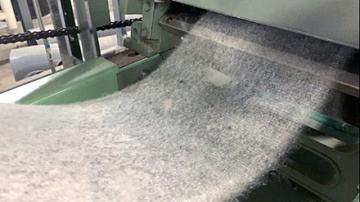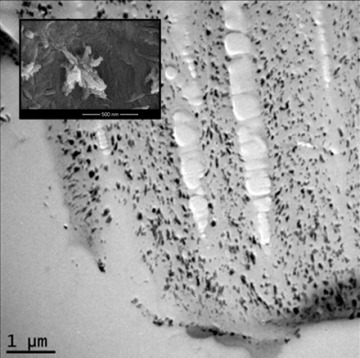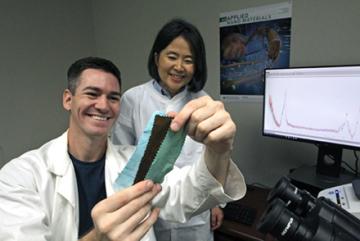Nanotech Super-Fabrics: Killing Germs, Saving Money, Reducing Waste

Cotton web containing the copper oxide nanoflowers produced in the Cotton Textile Mill pilot plant using a mini-carding system. It can be used as is, or further processed to create durable nonwoven fabrics. (Photo courtesy of Matthew Hillyer)
ARS Researchers Use Tiny Particles to Create Huge Antimicrobial Capabilities
At a time when a global pandemic has sent shockwaves through society, the need for products to fight bacteria, viruses, and other pathogens has become more urgent than ever. Fortunately, ARS researchers have been working on powerful anti-microbial tools for years, and two ARS researchers recently built upon this technology to create revolutionary anti-microbial, antifungal, and antiviral cotton products engineered with silver and copper oxide nanoparticles.
For the past several years, Sunghyun Nam, research engineer at the ARS Southern Regional Research Center (SRRC) in New Orleans, LA, has been perfecting a technology to embed nanoparticles of silver – a known anti-microbial agent – in cotton fibers. The result is cotton-based textile products that have a powerful and lasting ability to kill germs. While some nanoparticle-treated textiles are already available in the market, they are produced using coating methods that render them far less effective against pathogens.
Typically, in the existing products, nanoparticles are applied to the surface of fabrics, and tend to rapidly detach when the resulting cloths are used and washed. The genius of Nam’s technique lies in the fact that the metallic nanoparticles are actually synthesized inside of the cotton fiber, binding them to it much more securely. The standard, widely-used process of generating nanoparticles involves two elements: a “reducing agent,” that is, a chemical that changes the precursor metal ions to their elemental form, and a “stabilizing agent,” that keeps the nanoparticles from clustering into a large particle. While the existing approach uses chemical additives to accomplish these functions, in Nam’s approach, because of the way the nanoparticles are synthesized inside the cotton, the fiber itself acts as both reducing and stabilizing agent.
The results have been astonishing. Cleaning cloths made from the nanoparticle-embedded cotton fibers retain their nanoparticles – and the associated antimicrobial properties – even after countless turns through a washing machine. That makes them better for both consumers and the environment: no more need to throw away mountains of disposable wipes. The nanoparticle-embedded cotton-based wipes are readily biodegradable.

Using an analytical method developed at SRRC, a cross-section of the cotton fibers can be imaged using Transmission Electron Microscopy (TEM) to confirm the internally formed copper oxide nanoflowers. Inset: Scanning Electron Microscope (SEM) image of an individual copper oxide nanoflower. (Photo courtesy of Matthew Hillyer)
Together with her collaborator, Matthew Hillyer, chemist at the ARS SRRC, Nam is now exploring opportunities to transfer the technology into the marketplace. Does that success mean the two are ready to pack up their lab and go home? Hardly. Having identified a revolutionary approach to embedding metallic nanoparticles in cotton fiber, Nam and Hillyer have been researching whether they can produce nanoparticles of other metals to demonstrate the versatility of the cotton synthesis process.
“We’ve created synthetic methods for internal dispersion, which hadn’t been done before, so we’re taking what we know about silver and applying it systematically to other metals,” said Hillyer.
Their search has taken them to copper oxide (also known as cuprous oxide), a metal compound that weds copper and oxygen molecules. Commercially, it is appealing because copper is significantly less expensive than silver. ARS has filed patent applications related to Nam’s cellulosic fibers comprising silver nanoparticles; Hillyer has developed cellulosic fibers comprising internally dispersed cuprous oxide nanoparticles for which ARS has also filed a patent application.
Part of the reason for copper oxide’s success lies in its shape.
“Unlike silver nanoparticles, which are spherical, copper oxide nanoparticles have a flower-like shape,” explained Nam. These copper oxide nanoflowers are grown within the cotton fiber—under a transmission electron microscope, numerous fragments of the flower are dispersed throughout the entire cross-section of the fiber.

ARS research chemist Matthew Hillyer and research engineer Sunghyun Nam examine copper oxide nanoflower cotton fabrics at different stages of the production process. (Photo courtesy of Matthew Hillyer)
That unique shape could soon blossom into a wide variety of other applications, such as sportswear, shoe liners, mattress fill, or pillow fill that inhibits the development of unpleasant odor and germs. One especially intriguing possibility is for members of the military, who might find themselves in places where they cannot wash frequently and need to avoid microbial contamination.
“Wound dressing with gauze would be a great application that we’ve talked about,” said Hillyer. He and Nam also foresee uses throughout medical establishments: in gowns, curtains, gloves, and masks.
Ultimately, the duo hopes the value of the product will expand the use of cotton fibers, as their unique process for self-producing nanoparticles cannot be achieved in synthetic fibers.
“We can boost the utilization of cotton in the textile industry,” said Nam. “The majority of raw materials used in the nonwovens industry are synthetic fibers such as polyester and polypropylene, so our goal is to invent a new value for cotton, so we can expand its usage.
“The synthesis of metallic nanoparticles using cotton fibers will also open a new pathway to the development of affordable and sustainable nanotechnology.”
With the threat of dangerous microbes only growing, Nam and Hillyer’s work seems poised to do just that. – by Kathryn Markham, ARS Office of Communications.

